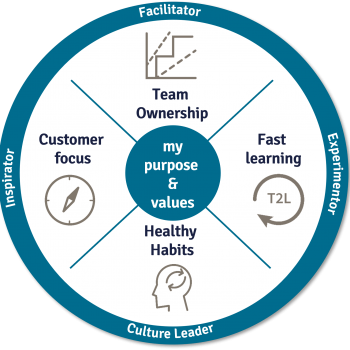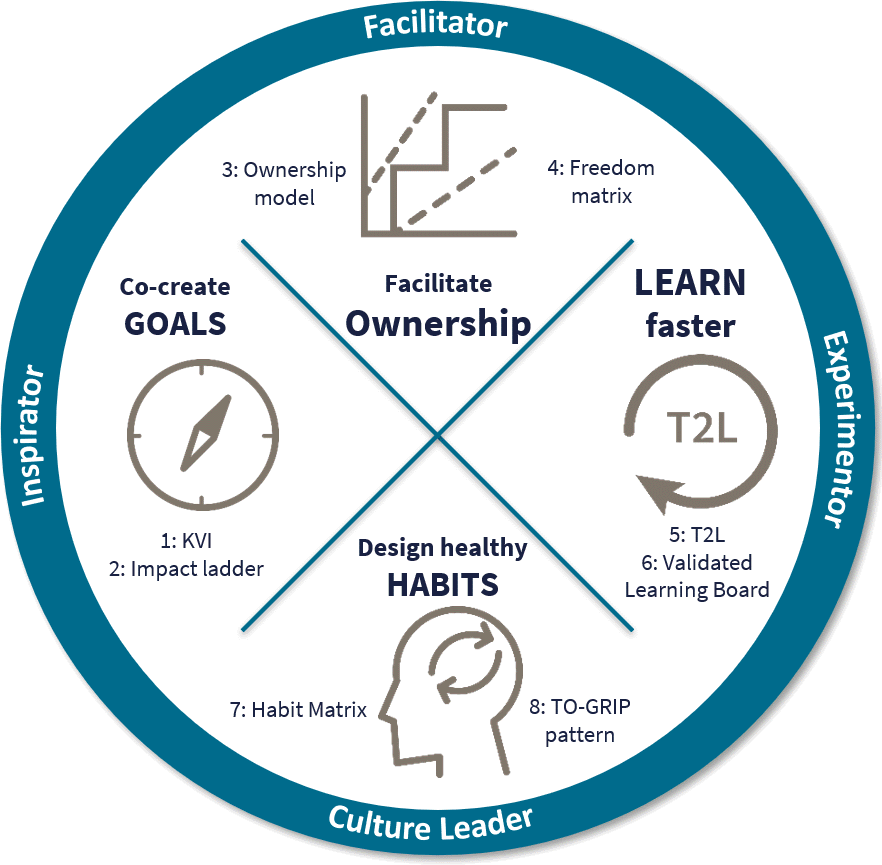
Leid met agility.
Bouw high-performang teams
Creëer een omgeving waarin teams eigenaarschap nemen, snel leren en continu verbeteren — juist in deze onvoorspelbare tijden.
The Steering Wheel of Agile Leadership
Agile teams thrive in environments with clarity, ownership, learning, and healthy habits. Our proven framework helps leaders actively shape these four pillars.
- Customer focus - Clear, customer-focused goals energize and align your teams.
- Enable ownership - Offer just the right amount of freedom — tailored to each team’s maturity.
- Fast Learning - Shorten the feedback loops between customers and teams.
- Healthy habits - Build a culture that supports continuous improvement and shared values.

Agile leiderschap gaat niet over controle. Het gaat over het creëren van de juiste omgeving
Agile leiders bouwen de omgeving waarin teams kunnen groeien, initiatief nemen en échte klantwaarde leveren. In een snel veranderende wereld is dit de cruciaal.
Met de juiste mindset en tools kun jij teams begeleiden die zelfstandig, energiek en klantgericht werken.
Why does this matter now?
Your leadership is the multiplier for team success.
Agile ways of working alone aren’t enough. Scrum, Kanban or sprints won’t deliver results if your leadership style holds teams back. You need a new leadership approach — one that energizes, empowers, and enables your teams.
1. Customer Focus
Customers expect more and more service from companies. They can easily switch providers online. Through social media, customers also have more influence on the image of companies. It is therefore essential for an agile leader to optimally attune his teams to the customers and the customer journeys. Find out how to facilitate this and how a Key Value Indicator helps.
2. Team Ownership
When your team takes ownership, it means that team members are proactive, proud, initiating and engaged. They don’t wait for assignments from you, but they take the initiative themselves. It’s the leader’s responsibility that teams take ownership. The challenge for an agile leader: finding the balance between micromanagement and total freedom. Read how an ownership model supports this.
3. Learn Faster & Agility
Today’s product or service doesn’t fit tomorrow’s challenge. But it’s hard to plan for the unknown. That is why your organization needs to offer flexible and agile solutions. This is only possible with employees with various skills in specialized teams that work closely together. Read how to get started with the agility of your team, and how to measure progress with a Time-2-Learn metric.
4. Healthy Culture & Habits
The job of an agile leader is to envision, shape and continuously improve the optimal company culture. You can achieve this by consistently setting a good example through your agile leadership skills. And by discussing which habits get in the way of the new company culture during team sessions. Get more insights and discover how the practical Habit Matrix tool can support you.
Creating the right context
The agile leader is responsible for creating the right context for the self-managing teams. So these teams can grow, deliver more value to the user, take ownership and basically thrive. To be successful in this new role, the agile leader needs a new mindset, new tools and steer on different things. The agile leadership toolkit is a practical way for the agile leader to start! This book is all about four components and 8 tools.Agile Leadership in a nutshell
Do you want a quick summary of these tools? Watch this video and learn from Jill.The toolkit
The steering wheel of the agile leader consists of four components. Each component consists of two practical tools. So in total eight tools. The tools are explained in such a way that leaders can immediately start working on this. The tools can be used separately and as such successful. Of course, all tools together – the toolkit – reinforce each other. It concerns the following eight tools:- KVI – the Key Value Indicator (KVI) is the most important indicator for value creation for the team.
- Impact ladder – for brainstorming and visualizing the customer impact. This helps teams continuously improve their products and services.
- Ownership model – visualizes what teams need to take ownership.
- Freedom matrix – what freedoms and responsibilities does the team have at what time.
- T2L – to measure the business agility.
- Validated Learning Board (VLB) – to visually keep track of the learning process of the team.
- Habit matrix – to support culture change and the design of new habits.
- TO-GRIP – to support the agile leader in implementing major improvements.

